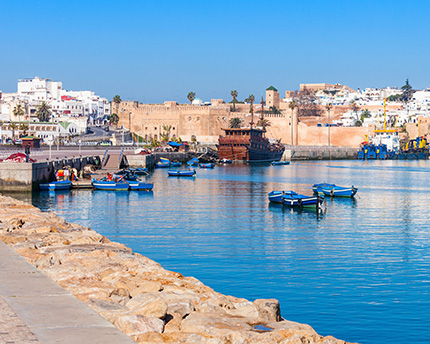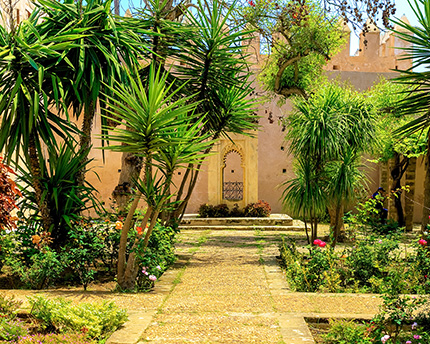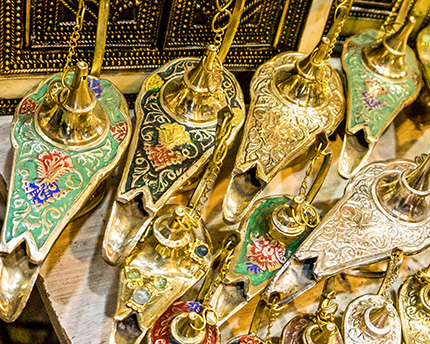Today, few Jews remain in Morocco’s ‘mellah’, walled Jewish quarters that were created in a number of Moroccan cities. There was a mass exodus of Jews from Morocco when the State of Israel was created in 1948, despite the fact that the Jewish community had lived in North Africa for far longer than the Arabs.
Like other Jewish quarters, the 19th century Mellah of Rabat was abandoned by the Jewish population at this time and today is mainly inhabited by Muslims. It is next to the Great Mosque, by the eastern part of the Andalusian Wall (Rabat’s walls are over 5 km long and surround the Medina on three sides). It lies on the small cliffs above the Bou Regreg River, and you enter it through Bab Mellah Gate.
Stroll along its narrow streets and buying typical products from the stalls you pass along your way is a great way to spend a morning or afternoon in the capital of Morocco.
History
Fez was the first Moroccan city to have a mellah, which was built in 1438. Marrakech built one in the 16th century, Meknes in the 18th century, and Rabat, Mogador, Salé, and Tetuán joined them in the 19th century. The Mellah of Rabat was built during the reign of Sultan Slimane, who forced all the Jews living in Rabat to move to this area.
The mellah were places where the Jews lived separately from the Muslims and could follow their own way of life; they had their own markets and facilities, and were granted religious freedom and administrative independence. Mellah also had a series of common features: they were walled zones with royal guards at the gates, and a curfew that closed off the neighbourhood at night so that no one could enter or leave. They were also typically located near the royal palace because members of the Jewish community were often employed by the court and were under official protection.
Their urban plan was inspired by Muslim medinas, but they were more regular in shape. However, population density was extremely high inside these neighbourhoods due to their small size, leading to overcrowding and unsanitary living conditions.
By the end of the 19th and beginning of the 20th century, prior to the creation of Israel and the mass exodus of the Jews in the 1950s, the Jewish population had already begun to move out, to more modern, European-style neighbourhoods, and only the elderly remained in the mellah.
Today, you can often spot Jews with Moroccan roots who live in Israel returning to cities like Rabat to discover the history of their ancestors.
What to see in the neighbourhood
You enter the Jewish Quarter of Rabat through Bab Mellah Gate on Avenue de Hassan II, by the eastern part of the Andalusian Wall.
While exploring the Mellah of Rabat, make sure to stop at Rabbi Shalom Zaoui synagogue. It was named after a 19th century rabbi who was said to be able to cure the sick, and the current building was once the rabbi’s home. At its height, the Mellah of Rabat had over a dozen synagogues.
Visitors to this city neighbourhood spend their time strolling along its narrow streets, buying typical goods from colourful street stalls and markets crammed into tiny spaces, and admiring the area’s traditional homes. Another enjoyable walk is along the seafront promenade that is reached through Bab Mellah Gate.
Rue du Mellah, Rue de Rabbin Shalom-Zaoui and Rue David-Cohen are the three main streets in the Mellah of Rabat. Redevelopment work began in the neighbourhood a few years ago to make it a further attraction in Rabat’s Medina.
Where to eat in the area
Visitors to Morocco shouldn’t leave without trying a tagine, a type of meat stew that is prepared with a delicious combination of spices such as cumin, turmeric, and ginger. You should also sample a couscous dish, made with steamed wheat semolina that is served with vegetables and lamb in a flavoursome sauce.
Another fun dining experience to try in the Medina and Mellah of Rabat is buying something from the many street food stalls. You can choose from a wide range of sandwiches made from freshly baked bread, and kebabs, among other options.
There are also plenty of restaurants in the area to choose between, and a couple of recommendations are: Dar Zaki, in the Medina, a comfortable spot that serves traditional Moroccan dishes that are great value for money, and Dar Naji, next to Bab el Had Gate and the walls, another popular restaurant serving local food.



































































